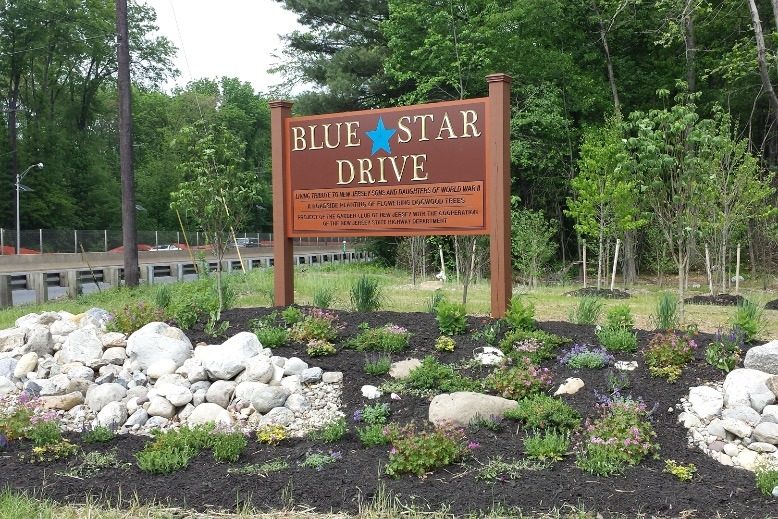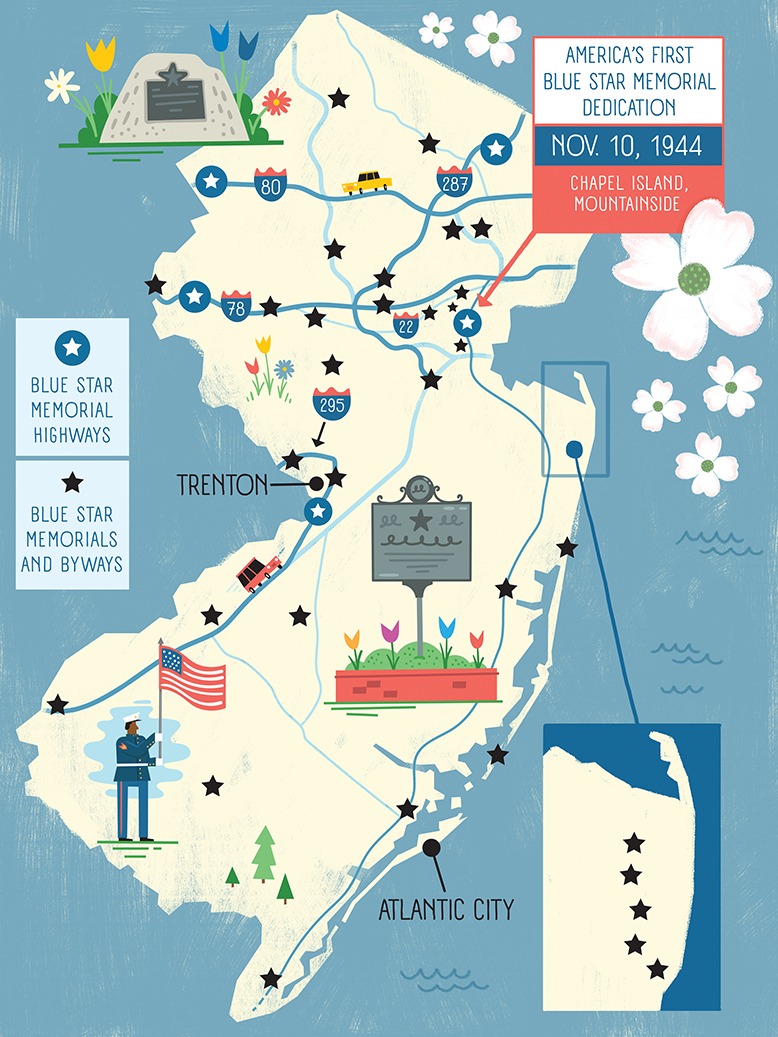
Drive west on Route 22 from Mountainside to North Plainfield, and you’ll pass through a patchwork of brushy woods, gas stations, chain stores, diners, tire shops and shopping malls. It wasn’t always this way.
In 1944, as World War II slogged along in Europe and the Pacific, the Garden Club of New Jersey dreamed up an initiative to beautify a 5.2-mile stretch of Route 22 in Union and Somerset counties and dedicate it to those serving in the armed forces. It would be dubbed Blue Star Drive.
Working with the state’s Department of Transportation, the Garden Club planted 8,000 flowering dogwood trees along the roadway, then known as Route 29. Signs were posted designating the four-lane thoroughfare as “a living tribute to New Jersey sons and daughters” in the military.
New Jersey played an immense role in World War II. More than 560,000 men and women from the Garden State served; some 10,372 died. By the end of 1945, the soldiers were coming home and the Blue Star Memorial Highway concept, which started in New Jersey, was spreading nationwide.
“We shared it, but New Jersey still holds this program very close,” says Rumson resident Mary Warshauer, former president of the Garden Club of New Jersey and current president of National Garden Clubs Inc.

Illustration by Shaw Nielsen
Today, there are 39 Blue Star sites across New Jersey, including three new memorials that were to be dedicated this spring. Five New Jersey roads are designated Blue Star highways; the rest of the memorials are located in parks and other public places.
As president of the Garden Club of New Jersey in 1944, Helen Hull came up with the Blue Star concept, taking the name from the blue-star insignia displayed during the war at homes with a family member in the service. Hull, who lived in Boonton, enlisted the transportation department as a partner, and in November 1944, the first dogwoods—chosen because they are native to New Jersey—were planted at Locust Grove Union Chapel, a local landmark (also known as Mountainside Union Chapel) on an island between the east- and westbound lanes of Route 22.
Using the slogan, “A dollar plants a tree on the Blue Star Drive,” the Garden Club invited citizens to sponsor trees in honor of family members in the military. The state Legislature passed a joint resolution supporting Hull’s plan, and the state subsequently acquired undeveloped land along the route for plantings.
“We had the white and the pink dogwoods,” recalls 81-year-old Ruth Goense, a lifelong Mountainside resident and a former member of the now defunct Mountain Trail Garden Club.
The dogwoods along Blue Star Drive bloomed in spring and gave bright-red berries in the fall. “There were a lot of them,” says Goense. “It was a showpiece that all could see.”

The Blue Star Drive initiative was thought up in 1944 to honor those in the armed forces. Photo courtesy of the Garden Club of New Jersey
It was not to last. A blight virtually wiped out the dogwoods in the 1970s. Goense says pollution from automobile exhaust aided in their demise. Warshauer confirms, “Dogwood trees went through a terrible period. Sadly, they went out and weren’t replaced.”
Instead, retail and housing developments blossomed along the increasingly congested Route 22. Even Locust Grove Union Chapel, dedicated in 1901, was moved to a new Mountainside location in the 1970s, a victim of roadway modernization. A state-owned salt dome now stands in its place on what is still known as Chapel Island.
The Blue Star sign from Chapel Island, the easternmost point of Blue Star Drive, is currently in storage, but alert drivers can spot a nicely landscaped sign on the eastbound side of Route 22 at North Drive in North Plainfield.
Oddly, the most prominent reminder of the living memorial is the giant Blue Star shopping center sign in Watchung. But continue west on Route 22 into Hunterdon County, and you’ll find more appropriate Blue Star Memorials in Whitehouse Station (at the Cushetunk rest area opposite the Ryland Inn) and Annandale. Both sites have replicas of the original Route 22 Blue Star signs.
A memorial dedication in Sussex County, at the state fairgrounds in Augusta, is planned for April 30. At deadline, dates had not been set for dedications at two other new memorial sites: the West Milford rest area on Route 23 in Passaic County, and in Rio Grande on Route 9 in Cape May County. That leaves only two New Jersey counties without memorials: Gloucester and Hudson.
“My goal is to get a memorial in every county,” says Joan Cichalski, Blue Star Committee chairperson for the Garden Club of New Jersey since 2015. Gloucester County, she says, will probably have a memorial by the end of the year. In Hudson County, the state garden club is working with local and state authorities to place a marker in Liberty State Park.
Blue Star Memorials are among an array of sites that, on occasions like Memorial Day, Flag Day and Veterans Day, serve as reminders of the sacrifices made by America’s military personnel. “It’s an opportunity to reach back and touch history,” says retired U.S. Army Colonel Walter Nall, acting deputy commissioner for veterans affairs at the New Jersey Department of Military and Veterans Affairs. Further, he says, the Blue Star program “actually speaks to the character of the country itself and the care for the veterans’ community.”
Before installing a memorial, a local garden club must approach the statewide club; in other instances, the statewide group will contact a local club in an area where it would like to place a memorial. In addition to highway markers, the program has memorial markers (placed at national cemeteries and veterans’ hospitals, for example) and byway markers (plaques installed in parks, civic gardens and historic sites).
Under state legislation renewed in 1999, Blue Star Memorials require approval by a seven-person Blue Star Council. The council comprises four representatives from the Garden Club of New Jersey, plus one representative each from the state Department of Transportation (DOT), the Department of Military and Veterans Affairs, and the Department of Environmental Protection.
Cichalski praises the DOT as an effective partner. The DOT helps local garden clubs landscape and maintain the sites and repair or replace missing signage. The department also rules on the viability of prospective sites. “We want it to be safe, especially if someone is going to have to maintain the site,” says Lois Johann, project engineer/landscape for the DOT and the department’s representative on the Blue Star Council.
Adds Cichalski: “We try not to have these become hazards where people are whizzing by and want to slow down to see them. Some of the older ones are in very busy areas.”
These days, Blue Star signs and plaques are more likely to turn up in parks or highway rest areas, where people can stop and ponder the meaning of the memorial. In some places—such as Little Silver, Westfield and Haddonfield—they are clustered with other military monuments. In Lyons, Menlo Park and Vineland, they are located at veterans’ homes.
A byway marker in a small park on Ridgedale Avenue in East Hanover is positioned behind a Fallen Warrior monument and adjacent to a memorial for the victims of the September 11th attacks. In Basking Ridge, the Blue Star marker sits alongside a gazebo on North Finley Avenue and Allen Street. In Toms River, the marker is on Route 37, a major thoroughfare, but it’s at the entry to Winding River Park, so there is ample parking.
In addition to Route 22, New Jersey’s official Blue Star highways are sections of Route 78 (with two markers at the Bloomsbury rest area in Hunterdon County); Route 295 (with a marker in Bordentown at the River Overlook, two miles south of Route 195/exit 60 in Burlington County); Route 80 (with a marker at the Knowlton visitor information center in Warren County); and Route 287 (with a marker at the Route 202 interchange in Oakland in Bergen County). The 1999 legislation stipulates a total of 238 miles of Blue Star roadway in the state.
It costs $1,590 to sponsor a highway or memorial marker, and $530 for a byway marker. Generally, local garden clubs raise the money with help from the statewide club. Maintenance and annual plantings are funded by the clubs and the DOT, which, Johann says, has about $50,000 budgeted each year for care of the memorials and similar projects.
Some 77 years after the first dogwoods were planted on Route 22, the Blue Star Memorials remain a source of pride for the state’s garden clubs. Warshauer says there are 105 clubs in the state, with about 4,500 members. Nationwide, there are about 6,000 clubs and approximately 200,000 members. Through their efforts, Blue Star highways have been dedicated in every state.
“You get no one who is opposed to this,” says Cichalski. “Who doesn’t want to honor veterans these days?”
Adds Warshauer: “It’s for those who have served, are serving, or will serve, and is a wonderful living memorial, for sure.”
Ken Schlager is the former longtime editor of New Jersey Monthly.



